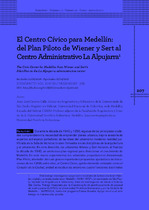El Centro Cívico para Medellín: del Plan Piloto de Wiener y Sert al Centro Administrativo La Alpujarra

Ver/
Fecha
2017Autor
Cuervo Calle, Juan José
Tipo de contenido
article
Citación
Metadatos
Mostrar el registro completo del ítemDocumentos PDF
Resumen
Durante la década de 1940 y 1950, algunas de las principales ciudades comprendieron la necesidad de emprender planes urbanos, bajo la asesoría de expertos extranjeros portadores de las ideas del urbanismo moderno; realidad justificada en la falta de técnicos locales formados en las disciplinas de la arquitectura y el urbanismo. En esta dirección, los urbanistas Wiener y Sert iniciaron, al finalizar la década de 1940, un ambicioso plan regional para direccionar el crecimiento de Medellín. En este marco experimental, los urbanistas proyectaron el denominado Plan Piloto, alrededor del cual giraron importantes propuestas ajustadas a las discusiones de los CIAM, entre ellas, el Centro Cívico, quinto elemento señalado como el Corazón de la Ciudad, unidad acrecida a las anteriores cuatro funciones doctrinales del urbanismo moderno: habitar, trabajar, cultivar el cuerpo y el espíritu y circular. En esta dirección, este trabajo expone uno de los escenarios de mayor trascendencia en el Plan Piloto para Medellín: El Centro Administrativo La Alpujarra, «Corazón» de Medellín. El reconocimiento por la necesidad de un Centro Cívico para Medellín exigió la premura de encontrar soluciones a la necesidad colectiva de espacio público. Esta fue la oportunidad colectiva para discutir y plasmar estos deseos sociales a través de dos concursos arquitectónicos organizados por la Sociedad Colombiana de Arquitectos, con el fin de proyectar dicho Centro Cívico: el primero en 1960 y el segundo en 1968. Este artículo expone, además del contexto en el que desarrollaron tales propuestas, los proyectos ganadores que permitieron comprender la idea de modernidad expresada a través de la vía institucional. During the decade of 1940 and 1950, some major cities understood the need to undertake urban plans, under the advice of foreign experts, carriers of the ideas of modern urbanism. This reality was justified in the absence of local technicians trained in the disciplines of architecture and urbanism. In this direction, town planners as Wiener and Sert began, at the end of the decade of 1940, an ambitious regional plan to address the growth of Medellin. In this experimental context, the planners projected the so-called Pilot Plan, around which revolved important proposals tailored to the discussions of the CIAM, including the Civic Center, fifth element designated as the Heart of the City, bigger unit than the previous four doctrinal functions of modern urbanism: live, work, cultivate the body and spirit, and circulate. In this direction, this work exposes one of the scenarios of greater importance in the Pilot Plan for Medellín: The Alpujarra Administrative Center, «Heart» of Medellín. The recognition for the need of a Civic Center for Medellin demanded the urgency of finding solutions to the collective need for public space. This was the collective opportunity to discuss and reflect these social desires through two architectural contests organized by the Colombian Society of Architects, in order to project the Civic Center: the first took place in 1960 and the second in 1968. Apart from the context in which such proposals were developed, this article shows the winning projects allowing to understand the idea of modernity expressed through the institutional route.
Palabra/s clave
Centro Cívico
La Alpujarra
Modernidad
Medellín
Wiener y Sert
Civic Center
La Alpujarra
Modernity
Medellín
Wiener and Sert
Colecciones
El ítem tiene asociados los siguientes ficheros de licencia:

